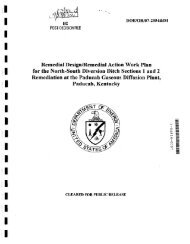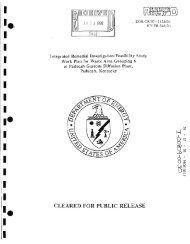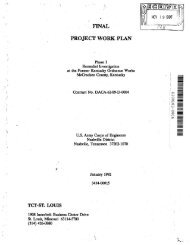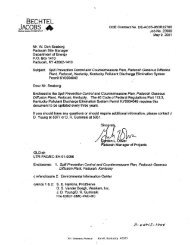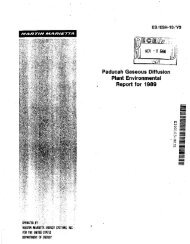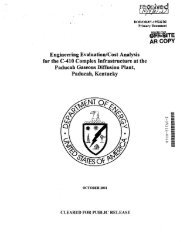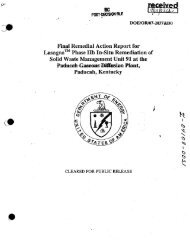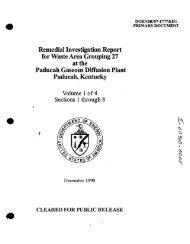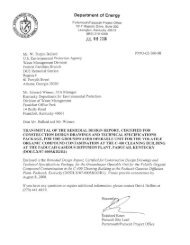1 - paducah environmental information center
1 - paducah environmental information center
1 - paducah environmental information center
Create successful ePaper yourself
Turn your PDF publications into a flip-book with our unique Google optimized e-Paper software.
Annual Site Environmental Report for 1999<br />
Table A.1 Comparison and Description of Various Dose L.evels<br />
Dose level<br />
mrem (0.01 mSv)<br />
2.5 mrem (0.025 mSv)<br />
10 nirem (0.10 mSv)<br />
45 mrem (0.45 mSv)<br />
46 mrem (0.46 mSv)<br />
66 mrem (0.66 nisv)<br />
100 mrem (1.00 mSv)<br />
110m re m (1.1 0 m S v )<br />
244 mrem (2.44 mSv)<br />
300 mrem (3.00 mSv)<br />
1-5 rem (0.01-0.05 Sv)<br />
5 rem (0.05 Sv)<br />
10 rem (0. 10 Sv) ,<br />
25 rem (0.25 Sv)<br />
75 rem (0.75 Sv)<br />
50-600 rem (0.50-6.00 Sv)<br />
Description<br />
Approximate daily dose from natural background radiation. including<br />
radon.<br />
Cos~ic dose to a person on a one-way airplane flight from New York to<br />
Los Angeles.<br />
ADliual exposure limit. set by the EPA for exposures from airborne<br />
em issions from operations of nuclear fuel cycle facilities; including power<br />
plants and uranium mines and mills.<br />
A verage yearly dose fro'm 'cosm ic radiation received by people in the<br />
Paducah area. .<br />
Estimate of the largest dose any off-site person could have received from<br />
the March 28 .• 1979. Three M lie Island nuclear.power plant accident.<br />
Average yearly dose to people in the United States from human-made<br />
sources.<br />
Annual limit of dose from all DOE facilities to a mem ber of the public<br />
Who is not a radiation worker.<br />
A verage occupational dose received by U.S. com m ercial radiation<br />
workers in 1980.<br />
A verage dose from an upper gastrointestinal diagnostic X -ray series.<br />
A verage yearly dose to people in the United States from all sources of<br />
natural background radiation.<br />
EPA protective action guidelines state that public officials should take<br />
emergency action when the dose to a member of the public from a nuclear<br />
accident will likely reach this range.<br />
Annual limit for occupational exposure of radiation workers set by NRC<br />
and DOE.<br />
The BEIR V report estimated that an acute dose at this level would result.<br />
in a lifetime excess risk of death from cancer. caused by the radiation. ciT<br />
0.8% (B EIR 1990).<br />
EPA guideline for voluntary maximum dose to emergency workers for<br />
non-lifesaving work during an emergency.<br />
EP A guideline for maxim um dose to. em ergency workers volun tee ring for<br />
lifesaving work.<br />
Doses in this range received over a short period of time will produce<br />
radiation sickness in varying degrees. At the lower end of this range.<br />
people are expected to recover completely. given proper medical<br />
attention. At the top of this range. most people would die within 60 days.<br />
. ~';::'.<br />
Adapted from Savannah River Site Environmental Report/or 1993. Summary Pamphlet. W SRC-TR-94-<br />
076. Westinghouse Savannah River Company. 1994.<br />
Appendix A A-7



